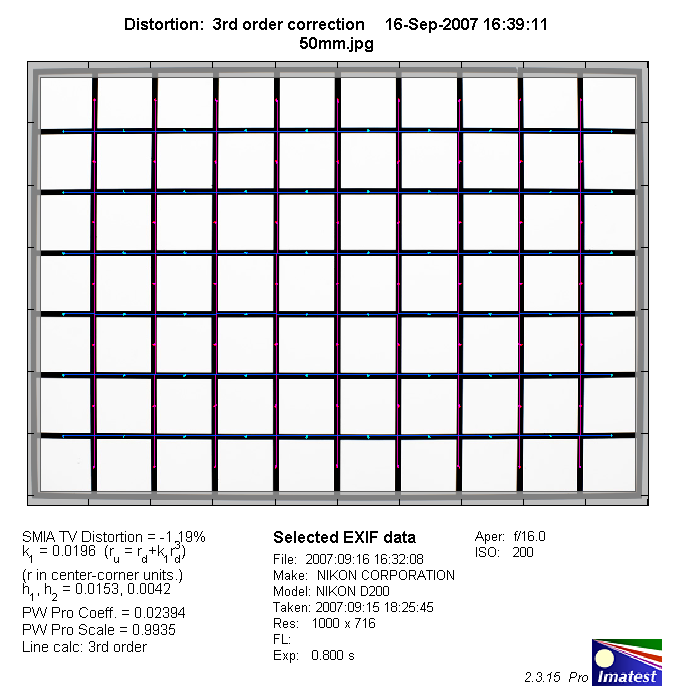|
Page 2 of 2

Distortion
The level of distortion is reasonably well controlled for a zoom lens. At 50mm there is relatively pronounced barrel distortion (~1.2%) changing to a similar degree of pincushion distortion (~1.1%) at 135mm. At 85mm the two forces even out (~0.4%).
|
Move the mouse cursor over the focal length text marks below to observe the respective distortion
|
| 50mm |
85mm |
135mm |
|

|
The chart above has a real-world size of about 120x80cm.
Vignetting
The Tokina is a dedicated APS-C lens so the vignetting is a little bit more pronounced at f/2.8 (~0.4-0.8EV). However, this is still pretty decent for such a kind of lens. As usual, stopping down reduces the issue.

MTF (resolution)
The lens shows very good to excellent sharpness in the image center and mostly good to very good sharpness at the image borders and corners, at least when stopped down a little. At the longest focal length setting the borders and corners show less resolution wide open, but they recover mostly by stopping down.
The lens suffered a little from field curvature which may result in softer corners when shooting flat objects with a shallow depth-of-field.
Please note that the MTF results are not directly comparable across the different systems!
Below is a simplified summary of the formal findings. The chart shows line widths per picture height (LW/PH) which can be taken as a measure for sharpness.
If you want to know more about the MTF50 figures you may check out the corresponding Imatest Explanations

Chromatic Aberrations (CAs)
The Tokina lens produces quite pronounce lateral Chromatic aberrations (color shadows at harsh contrast transitions) towards both ends of the zoom range. However, CAs can easily be removed in post processing and current Nikon DSLRs already do this in camera (if you shoot JPG).

Bokeh
One of the primary usage scenarios for a large aperture lens is to separate the main subject from the background. In such an image the quality of the bokeh (out-of-focus blur) is of major significance.
The image blur the lens produces is a bit on the nervous side wide open. This is also visibl ein background highlights, which show pronounced outlining wide open. Both, highlights and general bokeh quality, improve by stopping down a little. However, that's usually not what you want to do when trying to isolate the main subject.

Bokeh Fringing
Bokeh fringing (non-coinciding focal planes of the various colors) is a common issue with relatively fast glass. As you can notice below, the halos have different colors - magenta (red + blue) in front the focus point and green beyond. Truly "apochromatic" lenses don't show this kind of fringing but these lenses are very rare especially below 100mm. Unlike lateral lateral CAs, bokeh fringing cannot easily be fixed in post processing.
The tokina shows a moderate amount of bokeh fringing wide open, which is reduced to an unnoticeable level by stopping down.
Sample Shots
Unfortunately we had to go to through several copies of the lens to find one that we could use for the lab tests. In case you're interested, you can read about our odyssey in this thread in our forum.
None of the units we had was free of flaws. We found either centering issues, which made lab tests impossible, or, like with the final unit reviewed here, focus issues in the field, usually a pronounced back-focus. That's why we eventually decided not to include sample images. To be honest, we somewhat lost patience over time...
Verdict
The Tokina AF 50-135mm f/2.8 AT-X Pro DX is a very good lens with a few flaws. The resolution figures are generally very good, except for the long end of the zoom range, where the borders and corners drop in quality at large apertures. The contrast level is generally very high except at 135mmm f/2.8.
Typical for dedicated DX lenses the vignetting is a bit more pronounced at wide-open aperture but all-in-all the issue is still relatively well controlled. The distortion characteristic is about average for such a zoom lens, whereas lateral chromatic aberrations are a little high at both ends of the zoom range. The bokeh, the out-of-focus blur, is a bit nervous wide open, but improves by stopping down a little.
The mechanical quality of the lens is absolutely superb and it is a joy to handle this quality - more of this, please! The Tokina does still rely on the old slotted drive-screw for AF (which is not present anymore on Nikon budget DSLRs) - this approach is a bit dated by now although the principal AF performance is very fine.
So, in summary a very decent lens... if you manage to find a good copy.
|